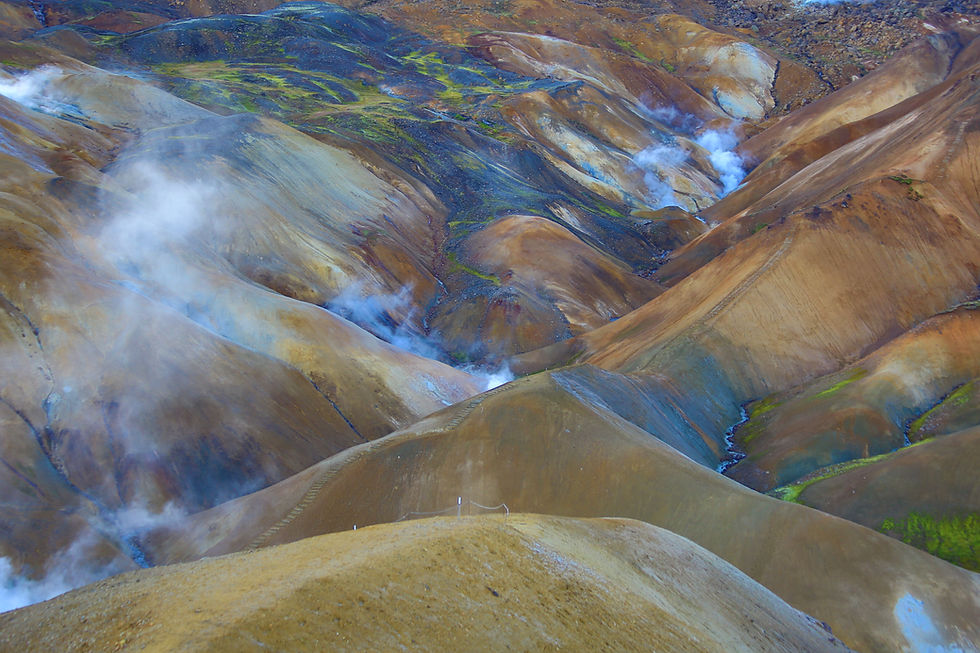Hualalai, Hawaii
- Mar 21, 2019
- 4 min read
Updated: Jan 3, 2023

Hualalai is the third most active and third youngest volcano (although it hasn't seen much action since 1801) after Kilauea and Mauna Loa on the island of Hawaii. Situated on the west side of island, above the town of Kailua-Kona, geologists estimated that this ancient volcano emerged from the bottom of the ocean approximately 300,000 years ago. In terms of geologic age, it is relatively an infant although it's shield building process has ceased and much of the surface of the volcano has undergone some erosion and transformation from the elements of nature. It surface rocks are mostly made of xenoliths, being brought to the surface from the earth's mantle. The soil on the flanks of Hualalai is rich in volcanic pumice, providing a perfect condition to grow coffee beans. When looking at its surface from Google Earth, Hualalai is dotted with many cinder cones; an eerie resemblance of our own Moon.

The highest point on Hualalai is located at a collapsed cinder cone called Hainoa situated at 8,271 feet. Due to the shape of a typical shield volcano, the peak is not very prominent and from afar, it does mirrors a warrior's shield lying on the ground. Hualalai is known to be a hiker's paradise, albeit the difficulty in accessing it as most of its land is privately owned by Kamehameha Schools, formerly Bishop Estate. There are many entry points and one such point is via Huehue St in Kaloko.
On April 3rd, 2015, we drove up to the end of Huehue St., which took us past a misty fern forest and private homes tucked away in the verdant wet Hawaiian forest. At slightly below 5,000 feet, we started our hike past several locked gates. The air was cool with a slight breeze was a nice welcoming touch to our long hike to Hainoa crater. Since we already shaved off 5,000 feet from sea level, the thought of climbing the rest of it was more of a delight and less of a despair; at least on paper.
The initial mile was on a graded road of approximately 25%. Here we briskly walked past many utility poles. Power is needed to run the transmission towers nearby.


In about 2.5 miles at an elevation of 6,000 feet, we reached a red cabin with the words "Uluha'o O Hualalai" engraved on it. On a side note, this cabin was built in the 50's and today, it is managed by a non-profit that conducts private tours in the surrounding area via ATV. The proceeds of the fund goes to manage and to educate young people to learn and to care for their land.
Since we had another 4 miles more before reaching Hainoa crater, we skipped resting and kept moving on. Moreover, we had to hike back out to the car and the last thing we wanted was to not have ample sunlight on our way back.


We followed the fence line, post the red cabin. Walking on lava rocks and forms of detritus proved to be quite harsh on our feet, even with sturdy hiking shoes on. The hike was getting a bit mundane, as we negotiated a few switchbacks uphill. Some parts of the trail was very sandy with loose rocks, which made it even more tiring to push off. In about 4.3 miles at approximately 6,876 feet of elevation, we came to the edge of a small crater. Many of these craters and lava conduits are not in the line of sight until one is almost on top of it. In essence, it will be a certain-death if one would to fall into one of these natural death traps, especially in the dark without proper illumination.


In between this nameless crater and Hainoa, we came across an open grassy field dotted with some experimental plantings. Many of the plants here look dead-ish. Windswept and very low in moisture, any other plants other than the native Ohia lehua or xeriscape plants will find it almost impossible to survive. In fact, many of the Ohia we came across were either dead or in the process of dying.

In the final mile before Hainoa crater, we edged along Honuaula forest, hiking up a graded path of about 30-40%. Many of the trees suffered the same consequence as the native Ohia we had seen earlier. Many were left standing without any foliage and many were blown down.

It is also here that we caught a glimpse of Hainoa crater - our turnaround point for the day. As we got out of the forest line, we were greeted with an open expanse of barren land consisting of basaltic lava rocks. I believe this is the end of the treeline as we enter the montane region of Hualalai. Vegetation consisted mainly of dwarfed ohia lehua and pukiawe (Styphelia tameiameiae) with its pretty berries.


After 6.7 miles we reached an elevation of 7,845 feet. We then decided it was time to make our journey back to the car. We had also ran out of water as we didn't anticipate this hike to be this long in such a harsh condition. We made it back to the car in under 8 hours, with an elevation gain of 3,678 feet, with much sunlight left, and unscathed. In retrospect, we would have enough time to summit Hainoa, just short of 426 feet from our turnaround point.
To experience this very special place, visit http://www.uluhao.com/crater-experience for more info on guided tours.















Wow —I lived in Kona for 10 years. So bummed I never explored this path. did most of my hiking on the costal areas towards the ocean - makai